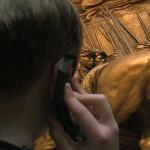April 22, 2011

Photo: VOA - A. Greenbaum
Using a smart phone with a camera and a special app, National Museum of the American Indian visitors can scan a smart tag graphic which takes them to links on the museum’s site.
The Luce Foundation Center for American Art is not your typical museum. It's an open storage facility at the Smithsonian American Art Museum which houses 3,300 works of art, leaving little room for written information.
"All the interpretation has to be digital and we have a great deal of it," says Georgina Goodlander, who was tasked with finding a way to get around the space problem.
Her solution allows visitors to access information about the works and the 1,200 artists who created them at one of 10 computer stations located throughout the space.
"We have hundreds of videos, audio clips, additional photographs, all kinds of cool stuff," says Goodlander. "But the one downside of those is you have to walk away from the artwork and sit down at a kiosk, so you are no longer looking at the artwork anymore "
An audio tour was the solution to that problem. Information on almost 200 works is accessible on cell phone or mp3 players provided by the museum.
"They will take out the device for a couple of hours and go on the audio tour," says Goodlander. "The cell phone is for more casual users I think."
At the National Gallery of Art, visitors listen to the curator telling them about Leonardo da Vinci's portrait of Ginevra de'Benci.
Recorded tours have been part of the National Gallery since the 1960s, but digital technology gives visitors more freedom. They can borrow an mp3 player at no cost and choose which works they want to learn more about by punching in a code.
"We offer it in English and five foreign languages," says Lynn Russell, head of the gallery's education department. "And we have just developed something that has shown itself to be extremely popular."
That would be an audio tour designed for children which features 50 works in the collection, like the Shaw Memorial by 19th century American artist Augustus Saint-Gaudens, which attracted John Gordy and his 11-year-old son Max.

VOA - A. Greenbaum
Digital technology gives National Gallery of Art visitor Max Gordy, 11, more options as he listens to an audio tour.Max enjoyed the audio tour. "It gives you tons of background information. It makes you think of it a lot more."
"It is really huge to have stuff geared to young people," says his father, John, "because his attention span is really good, but it wavers after a while."
The audio tours are popular , but you must borrow the player.
"Our reception isn't good everywhere inside these big stone marble buildings," says Russell. "Until we can ramp that up a little bit, I think using one's own device, either a cell phone or a smart phone, just doesn't seem to be the option that works best for visitors."
Inside the National Museum of the American Indian, visitors are invited to use their cell phones and smart phones in one exhibit. Symbols alongside artworks indicate additional material that's accessible through those devices.
This graphic is a QR code or smart tag. Using a smart phone with a camera and a special app, visitors scan the graphic, and they're taken to links on the museum's site.
Jason Wigfield, the museum's web developer, says smart tags provide him with information, too.
"I can see how many times one particular object is scanned versus others. So it is very good in measuring metrics on some of our visitors' activities in relationship to viewing objects."
There are still those who just want to look at the art and they can. But museums will increasingly offer options like smart tags for those who want more.